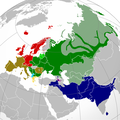Fajl:Indo-European branches map.png

Nav dijə kardej pamjə: 599 × 600 piksel. Čo iznon: 240 × 240 piksel | 479 × 480 piksel | 767 × 768 piksel | 1,023 × 1,024 piksel | 2,045 × 2,048 piksel | 2,934 × 2,938 piksel.
Ce fajli original (2,934 × 2,938 пиксел, фајли памјә: 2.16 MB, MIME тиспир: image/png)
Fajli tarix
Fajli syftə varianti vinde bə taryx/vaxti egətən.
| Tarix/Vaxt | Gədəlijə šikil | Pamjəjon | Ištirokəkə | Komment | |
|---|---|---|---|---|---|
| ysətnə | 07:43, 26 Sentjabr 2022 |  | 2,934 × 2,938 (2.16 MB) | Alexikoua | minor fixes |
| 19:58, 30 Mart 2022 |  | 2,934 × 2,938 (1.74 MB) | Whoop whoop pull up | Whoops, wrong file! | |
| 19:37, 30 Mart 2022 |  | 2,048 × 2,048 (980 KB) | Whoop whoop pull up | Misc fixes (Russian minority in Svalbard & Israel, Slovenian in SE Carinthia, Greek in N Epirus, Aromanians/Megleno-Romanians, Swedish essentially extinct in Estonia, etc. | |
| 13:37, 22 Dekabr 2021 |  | 2,934 × 2,938 (1.74 MB) | Ahmet Q. | Reverted to version as of 19:55, 23 August 2021 (UTC)seek consensus for your changes | |
| 00:40, 26 Nojabr 2021 |  | 2,934 × 2,938 (2.16 MB) | Alexikoua | rv elimination of Greek minority in Albania | |
| 23:55, 23 Avgust 2021 |  | 2,934 × 2,938 (1.74 MB) | Ahmet Q. | Rv false edit summary. Overrepresentation of Greeks in Turkey, Albania and Ukraine. Unexplained removal of Romanian in Serbia. Overall deterioration of the original file. Seek consensus for your changes. | |
| 20:16, 7 Avgust 2021 |  | 2,934 × 2,938 (2.16 MB) | Demetrios1993 | Addition of Arbereshe linguistic minority in Sicily. Addition of Serbian, Bosnian, and Gorani linguistic minorities in Kosovo. Addition of Greek linguistic minorities in Italy, Albania, Turkey, and Ukraine. Including some other minor corrections. | |
| 21:00, 19 Nojabr 2020 |  | 2,934 × 2,938 (1.74 MB) | Golden | update Armenian | |
| 22:42, 31 Mart 2018 |  | 1,479 × 1,479 (574 KB) | Maphobbyist | Removed area that exactly corresponds to the non-Indo European Lezgi linguistic area. | |
| 01:37, 7 Sentjabr 2016 |  | 1,479 × 1,479 (620 KB) | Rob984 | Georgia and Azerbaijan aren't majority multilingual. Older generations speak Russian from the Soviet era but now English is taught mainly in place of Russian. More people speak English in Finland, yet that isn't coloured. Also corrections to Celtic are... |
Fajli oko doj
4 səhifon oko dojdən ym fajl:
Fajli umumi oko doj
Ym fajl oko doə bejdə by vikijonədə:
- Oko doə bejdə ast.wikipedia.org
- Oko doə bejdə ban.wikipedia.org
- Oko doə bejdə be-tarask.wikipedia.org
- Oko doə bejdə be.wikipedia.org
- Oko doə bejdə bg.wikipedia.org
- Oko doə bejdə cs.wikipedia.org
- Oko doə bejdə da.wikipedia.org
- Oko doə bejdə de.wikipedia.org
- Oko doə bejdə en.wikipedia.org
- Oko doə bejdə en.wikiversity.org
- Oko doə bejdə es.wikipedia.org
- Oko doə bejdə et.wikipedia.org
- Oko doə bejdə eu.wikipedia.org
- Oko doə bejdə fa.wikipedia.org
- Oko doə bejdə fi.wikipedia.org
- Oko doə bejdə frr.wikipedia.org
- Oko doə bejdə fr.wikipedia.org
- Oko doə bejdə gl.wikipedia.org
- Oko doə bejdə gu.wikipedia.org
- Oko doə bejdə gv.wikipedia.org
- Oko doə bejdə hak.wikipedia.org
- Oko doə bejdə he.wikipedia.org
- Oko doə bejdə hy.wikipedia.org
- Oko doə bejdə hyw.wikipedia.org
- Oko doə bejdə ilo.wikipedia.org
- Oko doə bejdə incubator.wikimedia.org
- Oko doə bejdə io.wikipedia.org
Dijə karde končo umumi oko dojdən ym fajli.



